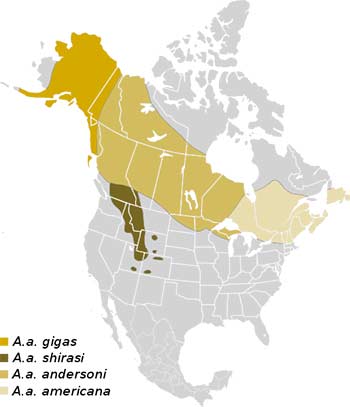In North America, Moose (Alces alces) are classified into four different subspecies. The Northwestern Moose (Alces alces andersoni) is found from Ontario to the Yukon and is the only subspecies known to occur in Manitoba.

Northwestern moose reach an impressive size (upwards of 600 kilograms, nine feet in length and over 6 feet at the shoulder). They are the largest member of the deer family, dwarfing the other species (mule deer, whitetail deer, elk and caribou) whose ranges overlap with their own in Manitoba.
Cervid size comparison chart copyMoose are strong swimmers and will take to the water to evade predators, seek relief from biting insects or simply to reach other areas of habitat. Their insatiable appetite is reflected in their name which derives from an Algonkian word referencing their taste for twigs and bark.
Moose feed on aquatic plants, non-woody plants and on deciduous woody trees and shrubs including birch, trembling aspen, poplar and red osier dogwood. They also eat balsam fir. Moose use dense evergreen stands for winter shelter and cows (mature females) seek out secluded areas to give birth to vulnerable calves.
As such, moose thrive in landscapes with a diversity of habitat types where woody shrubs and trees low enough to graze are in ample supply. This is typical of moist low areas like bogs, wetlands and lakes and can also be found as younger forests regenerate after a disturbance event such as a fire or timber harvest. Mature forest stands offer shelter but offer less feeding opportunities as the canopy is too high to reach and the underbrush is sparse due to the lower availability of light.
The lifespan of moose in the wild is estimated at 15-20 years. Moose are most vulnerable within the first year of their life. At any age, mortality can be caused by a number of factors including predation, parasites and disease, and hunting. Though moose have always negotiated these forces on the landscape, drastic changes to their habitat including those brought on by climate change and industrial activities, can exacerbate their impact.
When numbers drop to critical levels, chances of recovery become lower and the loss of a single animal has a greater impact on the population.
Ensuring Birth Rates
Reproduction
In Manitoba, mating occurs around late September when males (bulls) go into competition for access to mature females (cows). Calves are born in May or June when food is plentiful. Calves remain with their mother until she drives them away shortly before giving birth again in the following year.
Birth rates in moose are lower than in species such as white tailed deer, which tend to reach sexual maturity at an earlier age and are more likely to produce twins. This means moose populations need a longer time to rebound after periods of decline compared to other members of the deer family.
Bull moose can mate with more than one cow. Provided bull numbers are not critically low, removing a bull from a population has less of an impact on population numbers than removing a cow, especially if the cow is in prime breeding age.

Poor availability of habitat and food result in less growth and development in moose cows. This may impact population growth by:
- Delaying the age a female can reproduce.
- Decreasing the likelihood a cow will produce twins.
Higher quality habitat leads to healthier cows; healthier cows reproduce earlier and are more likely to produce twins.
Take Action
Save Our Moose
Moose may soon disappear completely from some parts of Manitoba, where the population has dropped by as much as 57 percent. Tell Manitoba's Premier to Save Our Moose.
Ensuring Healthy Moose Populations
Challenges & Opportunities
